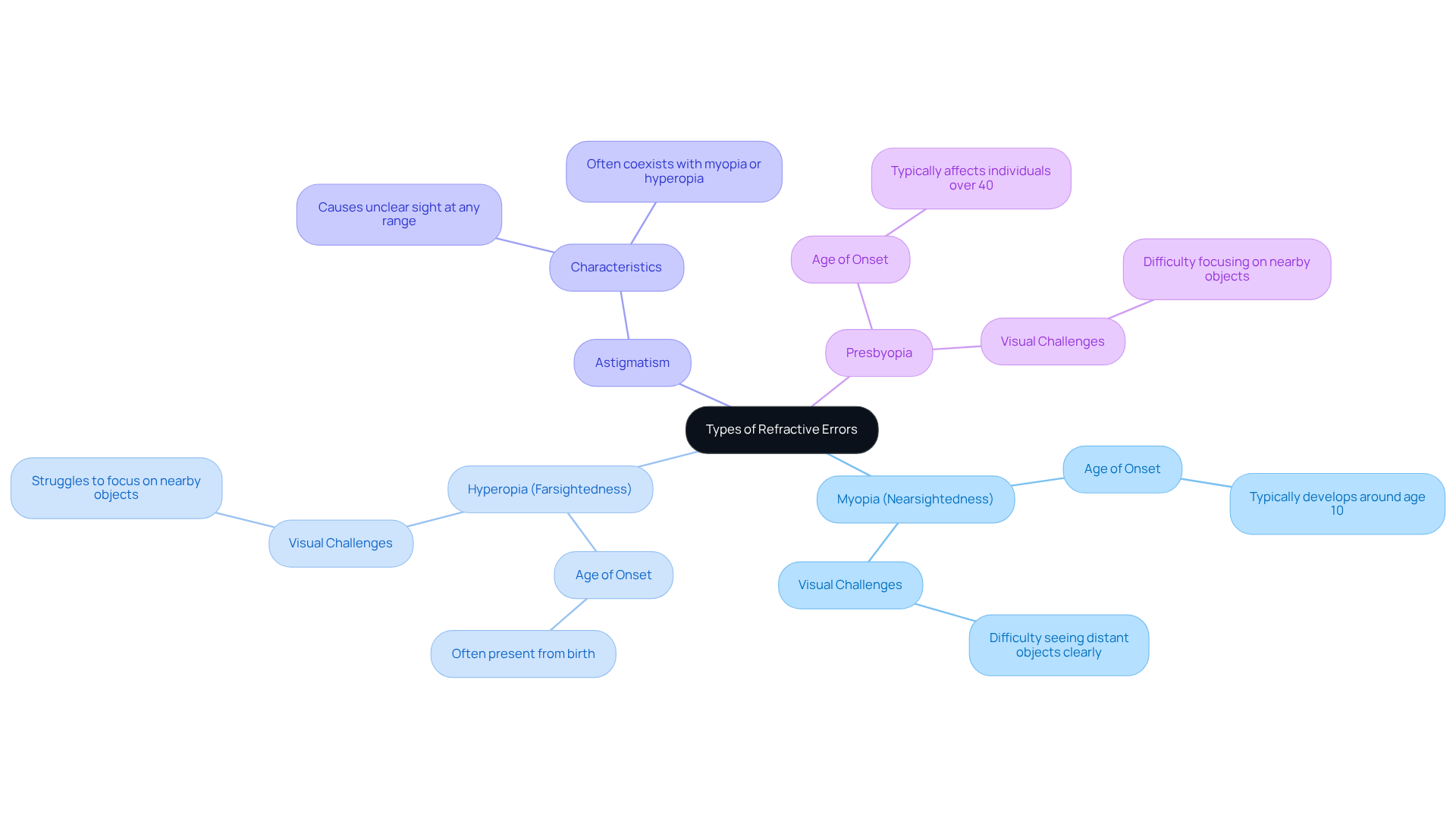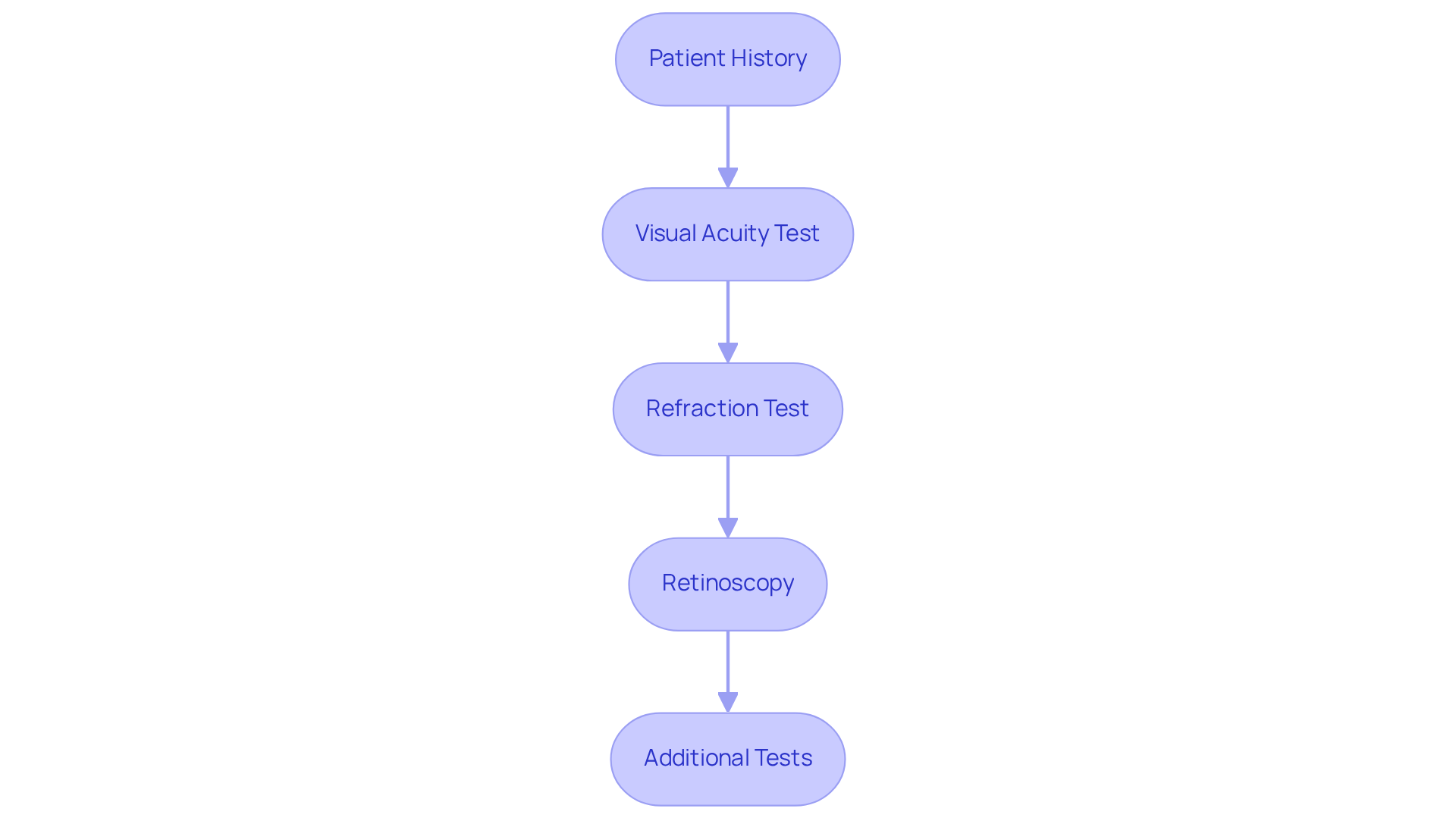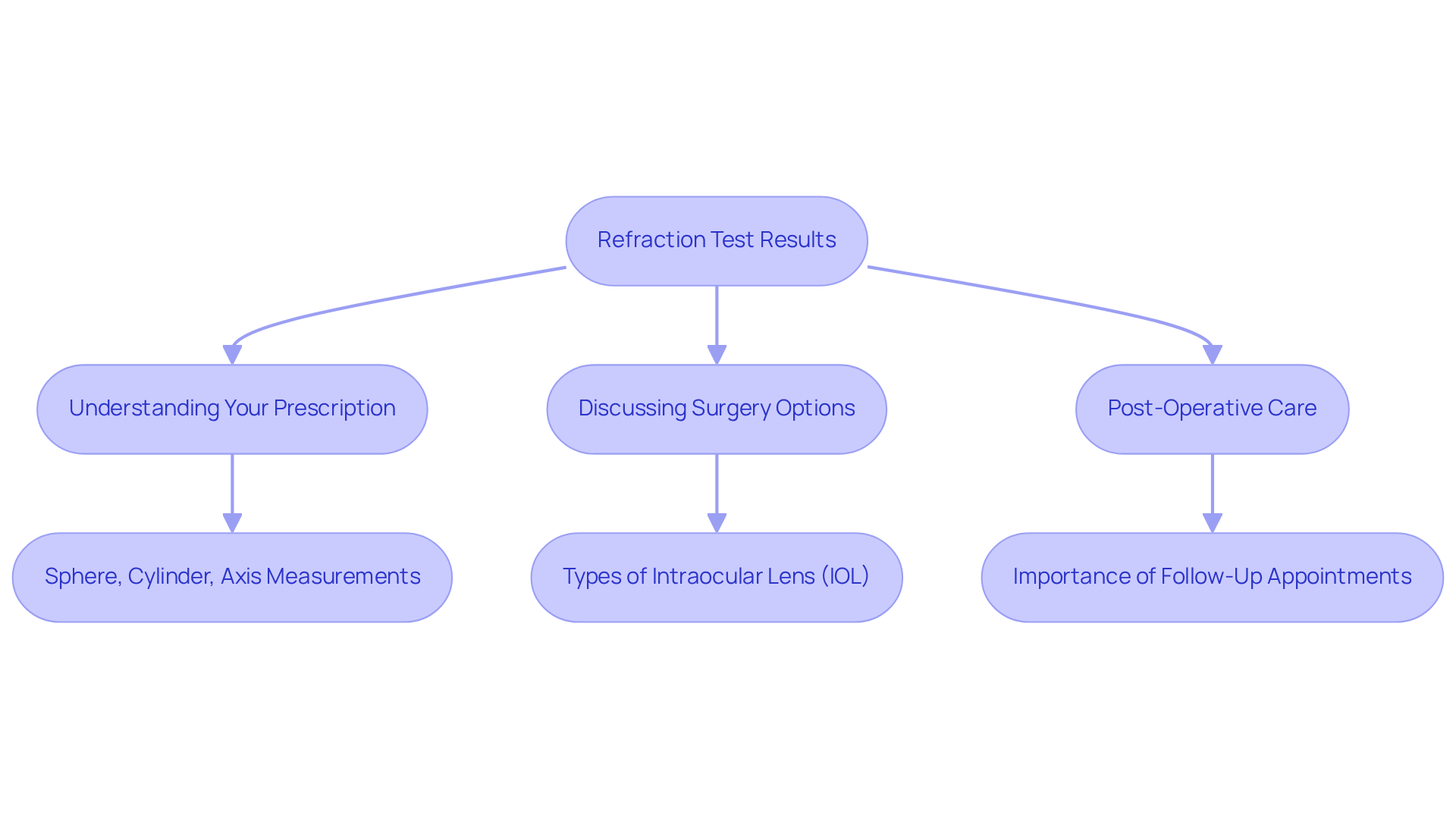Posted by: Northwest Eye in Cataracts, Vision Correction on October 25, 2025
Overview
Understanding eye refraction is crucial for cataract patients, as it explains how light is focused in the eye. This directly affects visual clarity and the necessity for corrective measures like cataract surgery. We understand that navigating these concerns can be overwhelming, and it’s important to feel informed about your options.
A clear understanding of refractive errors and the testing process can help you address your vision issues. Knowing what to expect can bring reassurance during this journey. Tailored solutions, such as the Light Adjustable Lens, can enhance your post-surgery outcomes, making a significant difference in your visual experience.
We are here to help you through this process, ensuring you feel supported every step of the way. It’s common to have questions and concerns, and we encourage you to seek the information you need to make informed decisions about your care.
Introduction
Understanding the mechanics of eye refraction is crucial for anyone facing cataract surgery. We understand that this can be a daunting experience, filled with questions and concerns. This intricate process, which involves the bending of light to achieve clear vision, becomes particularly significant for patients whose lenses are compromised. By delving into the types of refractive errors and the testing procedures involved, individuals can better appreciate the importance of corrective measures and the potential for improved sight.
It’s common to feel overwhelmed when considering what happens when the very foundation of vision is disrupted. How can patients navigate the complexities of eye refraction to ensure optimal outcomes in their cataract treatment journey? We are here to help you through this process, providing the support and information you need to feel confident in your decisions.
Define Eye Refraction and Its Importance
The bending of light as it travels through the eye’s focusing structure and cornea is known as eye refraction. This process is essential for clear vision, allowing us to focus on objects at varying distances. We understand that for those with lens issues, understanding eye refraction is particularly important. When the lens struggles to bend light correctly, it can lead to unclear or distorted vision.
By understanding this process, patients can appreciate the importance of corrective measures, such as cataract surgery. This procedure aims to restore optimal eye refraction and enhance visual clarity. It’s common to feel uncertain about such interventions, but knowing how they can improve your sight can be reassuring. Remember, we are here to help you through this process and support you every step of the way.
Explore Types of Refractive Errors
Refractive errors are common sight problems that can cause concern, occurring when the shape of the eye disrupts eye refraction and prevents proper focusing of light on the retina. We understand that navigating these issues can be challenging, so let’s explore the primary types together:
- Myopia (Nearsightedness): This condition makes it difficult to see distant objects clearly. It often develops in children around age 10 and is associated with an elongated eyeball or irregularities in the lens or cornea.
- Hyperopia (Farsightedness): Individuals may struggle to focus on nearby objects, typically due to a cornea that is too flat or an eyeball that is too short. This condition is often present from birth and can lead to challenges in daily activities, especially reading.
- Astigmatism: This results in unclear sight at any range due to an irregularly shaped cornea or optical element. It often exists alongside myopia or hyperopia, making sight correction more complex.
- Presbyopia: Commonly affecting individuals over 40, this condition is characterized by difficulty focusing on nearby objects as the eye refraction structure becomes less flexible with age.
We recognize that for patients with lens opacity, these refractive errors can greatly complicate sight problems. It becomes essential to assess and address them during the treatment process. The innovative Light Adjustable Lens offered by Northwest Eye provides a tailored solution that adapts to the specific refractive needs of patients post-surgery. This optical device allows for modifications after implantation, ensuring optimal vision correction.
Research suggests that individuals with eye refraction errors may experience varied results from lens surgery, as these conditions can influence the effectiveness of the procedure and the selection of intraocular lenses. Regular eye examinations are crucial for identifying these refractive errors early, allowing for timely intervention and optimal management of cataract treatment.
We are here to help you through this process. To learn more about how the Light Adjustable Lens works, we invite you to watch our video featuring insights from our specialists.

Describe the Eye Refraction Testing Process
The eye refraction testing process typically involves several important steps that we understand can feel overwhelming:
-
Patient History: Your eye care specialist will ask about your sight issues, medical background, and any current medications. This step is crucial for understanding your unique needs in terms of eye refraction.
-
Visual Acuity Test: You will read letters from an eye chart to determine how well you can see at various distances. This helps us gauge your current vision.
-
Refraction Test: Using a phoropter, the doctor will present different lenses to find the prescription that provides the clearest vision. We know how important it is to achieve the best clarity for you.
-
Retinoscopy: A light is directed into your vision to observe how light reflects off the retina. This assists in identifying your eye refraction error, ensuring we have an accurate understanding of your vision needs.
-
Additional Tests: Depending on your condition, further tests may be conducted to evaluate the health of your eyes and the presence of lens opacities. We want to ensure every aspect of your eye health is thoroughly assessed.
This comprehensive testing is essential for accurately assessing your eye refraction needs, which is crucial for planning effective cataract surgery. At Northwest Eye, we are here to support you with innovative solutions like the Light Adjustable Lens (LAL). This advanced technology enables personalized modifications to your sight after surgery, offering substantial advantages such as enhanced visual results and the ability to refine your prescription according to your lifestyle requirements. We understand that optimal clarity is essential, and we are dedicated to customizing your vision experience to meet your preferences.

Interpret Refraction Test Results and Next Steps
After the eye refraction test, we understand that you may have questions about the results. Your eye care professional will explain these results, which typically include your prescription for glasses or contact lenses, taking into account your eye refraction. If you have cataracts, the results can indicate how significantly your sight is impacted and whether surgery is advised.
-
Understanding Your Prescription: Your prescription will detail the necessary adjustments for optimal vision, including sphere, cylinder, and axis measurements. We want to ensure you feel confident in understanding what these terms mean and how they relate to your vision needs.
-
Next Steps: If surgery is indicated, your doctor will discuss the options available to you. This may include the type of intraocular lens (IOL) that may be suitable for your situation, including advanced options like Light Adjustable Lenses. We encourage you to ask questions and express any concerns you may have during this discussion.
-
Post-Operative Care: It’s common to feel anxious about recovery after cataract surgery. Understanding the importance of follow-up appointments and monitoring your recovery is crucial for achieving the best outcomes. This proactive approach ensures that any concerns are addressed promptly, leading to a smoother recovery process. Remember, we are here to help you through this process.

Conclusion
Understanding eye refraction is crucial for cataract patients, as it directly influences the clarity and quality of vision. We understand that the ability of the eye to bend light properly is essential for focusing on objects at various distances. When cataracts impair this process, patients may experience distorted or unclear vision. Recognizing the significance of eye refraction not only fosters an appreciation for corrective measures like cataract surgery but also provides reassurance about the potential for restored sight.
This article delves into various refractive errors such as myopia, hyperopia, astigmatism, and presbyopia. It’s common to feel overwhelmed by how these conditions complicate vision for cataract patients. We emphasize the importance of comprehensive eye refraction testing, which involves multiple steps to accurately assess an individual’s vision needs. By understanding test results and the implications for surgery, patients can make informed decisions regarding their eye care and treatment options, including advanced solutions like the Light Adjustable Lens.
Ultimately, grasping the nuances of eye refraction and its impact on vision empowers cataract patients to take proactive steps in managing their eye health. Regular eye examinations and timely interventions can significantly enhance the quality of life, allowing individuals to navigate their daily activities with confidence. Embracing this knowledge can lead to better visual outcomes and a deeper understanding of the journey toward clearer vision. We are here to help you through this process.
Frequently Asked Questions
What is eye refraction?
Eye refraction is the bending of light as it travels through the eye’s focusing structure and cornea, which is essential for clear vision.
Why is eye refraction important?
Eye refraction is important because it allows us to focus on objects at varying distances. Proper refraction is crucial for maintaining clear and undistorted vision.
What happens when the lens has issues with eye refraction?
When the lens struggles to bend light correctly, it can lead to unclear or distorted vision.
How can understanding eye refraction benefit patients?
Understanding eye refraction helps patients appreciate the importance of corrective measures, such as cataract surgery, which aims to restore optimal eye refraction and enhance visual clarity.
What is cataract surgery?
Cataract surgery is a procedure designed to improve eye refraction and visual clarity for those experiencing lens issues.
What should patients know about interventions like cataract surgery?
Patients may feel uncertain about interventions such as cataract surgery, but knowing how these procedures can improve their sight can be reassuring. Support is available throughout the process.






